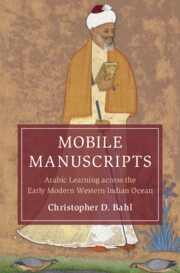Book contents
- Mobile Manuscripts
- Cambridge Oceanic Histories
- Mobile Manuscripts
- Copyright page
- Dedication
- Contents
- Figures
- Maps
- Tables
- Acknowledgements
- Notes on Dates, Places, and Transliterations
- Introduction
- 1 The Prosopographical World of Maritime Mobilities
- 2 The Royal Library of Bijapur
- 3 Arabic Philology in Early Modern South Asia
- 4 Mobile Arabic Learning from Egypt to the Deccan
- 5 From the Deccan to Istanbul
- Conclusion
- Appendix
- Bibliography
- Index
- References
Bibliography
Published online by Cambridge University Press: 30 January 2025
- Mobile Manuscripts
- Cambridge Oceanic Histories
- Mobile Manuscripts
- Copyright page
- Dedication
- Contents
- Figures
- Maps
- Tables
- Acknowledgements
- Notes on Dates, Places, and Transliterations
- Introduction
- 1 The Prosopographical World of Maritime Mobilities
- 2 The Royal Library of Bijapur
- 3 Arabic Philology in Early Modern South Asia
- 4 Mobile Arabic Learning from Egypt to the Deccan
- 5 From the Deccan to Istanbul
- Conclusion
- Appendix
- Bibliography
- Index
- References
- Type
- Chapter
- Information
- Mobile ManuscriptsArabic Learning across the Early Modern Western Indian Ocean, pp. 287 - 316Publisher: Cambridge University PressPrint publication year: 2025

